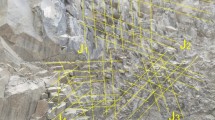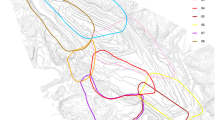Abstract
A system for the quantification of the failure hazard of rock cuttings structured in the form of rating tables is proposed. Rock cuttings are classified according to their failure hazard taking into account both their drained condition and the influence that climatic conditions have on stability; the latter being the most common landslide-triggering factor. The system deals with seven types of failure including slides, topples and falls. Where possible and convenient, parameters are amalgamated using well-established expressions of safety factor increasing the objectivity of the system. In addition to triggering mechanisms, site-specific parameters related to the mean and critical precipitation height, as well as the potential for the development of adverse, water-related conditions are taken into account to arrive at a Hazard Index value.
Résumé
Un système sur la quantification du risque d’échec des déblais rocheux structuré sous la forme des tableaux d’évaluation est proposé. Les déblais rocheux sont classifiés selon leur risque d’échec prenant en compte leur condition asséchée et l’influence des conditions climatiques sur la stabilité; le dernier facteur déclenchement des glissements de terrain est le plus commun. Le système traite avec sept types d’échec, glissements, renversements et éboulements rocheux sont compris. Lorsque cela est possible et pratique, les paramètres sont fusionnés en utilisant des expressions du facteur de sécurité connues, qui accroissent l’objectivité du système. En outre des mécanismes de déclenchement, les paramètres relatifs à la moyenne et à la hauteur critique de la précipitation du site spécifique, ainsi que la possibilité du développement des conditions négatives et relatives à l’eau, sont prises en considération pour arriver au Valeur du Risque.







Similar content being viewed by others
References
Anagnostopoulos C, Georgiadis M (1997) Analysis of rainfall data and correlation to landslides: the case of Sykia-Pieria, Greece. In: Proceedings of the International Symposium of the IAEG on engineering geology and the environment 1:483–487
Ayalew L (1999) The effect of seasonal rainfall on landslides in the highlands of Ethiopia. Bull Eng Geol Environ 58:9–19. doi:10.1007/s100640050065
Barton NR, Lien R, Lunde J (1974) Engineering classification of rock masses for the design of tunnel support. Rock Mech Rock Eng 6(4):189–239. doi:10.1007/BF01239496
Bieniawski ZT (1979) The geomechanics classification in rock engineering applications. In: Proceedings of 4th international congress for rock mechanics, ISRM 2:41–48
Brown ET (1981) Rock characterization, testing and monitoring, ISRM suggested methods. Pergamon Press, Oxford
Cardinali M, Galli M, Guzzetti F, Ardizzone F, Reichenbach P, Bartoccini P (2006) Rainfall induced landslides in December 2004 in South-Western Umbria, Central Italy. Nat Hazards Earth Syst Sci 6:237–260
Chau KT, Wong RHC, Liu J, Lee CF (2003) Rockfall hazard analysis for Hong Kong based on rockfall inventory. Rock Mech Rock Eng 36(5):383–408. doi:10.1007/s00603-002-0035-z
Chleborad AF, Baum RL, Godt JW (2006) Rainfall thresholds for forecasting landslides in the Seattle, Washington, area—exceedance and probability. US Geological Survey Open-File Report 2006–1064 (available from: http://pubs.usgs.gov/of/2006/1064/pdf/of2006-1064.pdf)
Crozier MJ (1999) Prediction of rainfall-triggered landslides: a test of the antecedent water status model. Earth Surf Process Landf 24:825–833
Flageollet JC, Maquaire O, Martin B, Weber D (1999) Landslides and climatic conditions in the Barcelonnette and Vars Basins (Southern French Alps, France). Geomorphology 30:65–78. doi:10.1016/S0169-555X(99)00045-8
Frayssines M, Hantz D (2006) Failure mechanisms and triggering factors in calcareous cliffs of the Subalpine Ranges (French Alps). Eng Geol 86:256–270. doi:10.1016/j.enggeo.2006.05.009
Goodman RE (1989) Introduction to rock mechanics, 2nd edn. Wiley, New York
Goodman RE, Bray JW (1977) Toppling of rock slopes. In: Proceedings of a Specialty Conference on rock engineering for foundations and slopes 2:201–234
Guzzetti F, Reichenbach P, Cardinali M, Ardizzone F, Galli M (2003a) The impact of landslides in the Umbria Region, Central Italy. Nat Hazards Earth Syst Sci 3(5):469–486
Guzzetti F, Reichenbach P, Wieczorek GF (2003b) Rockfall hazard and risk assessment in the Yosemite Valley, California, USA. Nat Hazards Earth Syst Sci 3(6):491–503
Guzzetti F, Peruccacci S, Rossi M, Stark CP (2007) Rainfall thresholds for the initiation of landslides in central and southern Europe. Meteorol Atmos Phys 98:239–267. doi:10.1007/s00703-007-0262-7
Hack HRGK (1996) Slope stability probability classification (SSPC). ITC Publication, Netherlands ISBN 90 6164 125 X. 258 pp (thesis, book, online)
Hoek E (2007) Practical rock engineering. Internet site: Hoek’s corner (available from: http://www.rocscience.com/hoek/Hoek.asp)
Hoek E, Bray JW (1981) Rock slope engineering, 3rd edn. Institution of Mining and Metallurgy, London
IUGS (1997) Quantitative risk assessment for slopes and landslides—the state of the art. In: Cruden D, Fell R (eds) Landslide risk assessment. Balkema, Rotterdam, pp 3–12
Komac M (2005) Intenzivne padavine kot sprožilni dejavnik pri pojavljanju plazov v Sloveniji (Rainstorms as a landslide-triggering factor in Slovenia). Geologija 48(2):263–279
Koukis G, Ziourkas C (1991) Slope instability phenomena in Greece—a statistical analysis. Bul Int Assoc Eng Geol 43:47–60. doi:10.1007/BF02590170
Koukis G, Tsiambaos G, Sabatakis N (1997) Landslide movements in Greece: Engineering geological characteristics and environmental consequences. In: Proceedings of the International Symposium on engineering geology and the environment 1:789–792
Koukis G, Sabatakakis N, Nikolaou N, Loupasakis K (2005) Landslide Hazard Zonation in Greece. In: Sassa K, Fukuoka H, Wang F, Wang G (eds) Landslides, risk analysis and sustainable disaster management. Springer, Berlin, pp 291–296. doi:10.1007/3-540-28680-2
Marinos P, Hoek E (2000) GSI: A geologically friendly tool for rock mass strength estimation. In: Proceedings of the International Conference on geotechnical and geological engineering (GeoEng2000), pp 1422–1442
Marinos P, Hoek E (2001) Estimating the geotechnical properties of heterogeneous rock masses such as flysch. Bull Eng Geol Environ (IAEG) 60:85–92. doi:10.1007/s100640000090
Marinos V, Marinos P, Hoek E (2005) The Geological Strength Index: applications and limitations. Bull Eng Geol Environ 64:55–65. doi:10.1007/s10064-004-0270-5
Maurenbrecher PM, Hack HRGK (2007) Toppling mechanism: resolving the question of alignment of slope and discontinuities. In: Proceedings of the 11th Congress of the ISRM. The second half century of rock mechanics 1:725–728
McCauley ML, Works BW, Naramore SA (1985) Rockfall mitigation—final report (FHWA/CA/TL-85/12). FHWA, Washington
Mouratidis A, Pantelidis L (2007) Rock failure risk assessment in highway maintenance management. In: Proceedings of the International Conference on advanced characterisation of pavement and soil engineering materials 2:1145–1154
Palmström A (1995) RMi—a rock mass characterization system for rock engineering purposes. PhD thesis, University of Oslo, Norway p 409
Palmström A (2001) Measurement and characterization of rock mass jointing. In: Sharma VM, Saxena KR (eds) In situ characterization of rocks. Balkema, Tokyo, pp 49–97
Pantelidis L (2009) Rock slope stability assessment through rock mass classification systems. Int J Rock Mech Min Sci 46(2):315–325. doi:10.1016/j.ijrmms.2008.06.003
Rapp A (1960) Recent developments of mountain slopes in Kärkevagge and surroundings, northern Scandanavia. Geografiska Annaler 42(A):71–200
Trigo RM, Zêzere JL, Rodrigues ML, Trigo IF (2005) The influence of the North Atlantic Oscillation on rainfall triggering of landslides near Lisbon. Nat Hazards 36:331–354. doi:10.1007/s11069-005-1709-0
Varnes DJ (1978) Slope movement types and processes. TRB 176:11–33
Wieczorek GF, Jäger S (1996) Triggering mechanisms and depositional rates of postglacial slope-movement processes in the Yosemite Valley, California. Geomorphology 15:17–31. doi:10.1016/0169-555X(95)00112-I
Wieczorek GF, Snyder JB, Alger CS, Isaacson KA (1992) Rock falls in Yosemite Valley, California. US Geological Survey, Open-File Report, pp 92–387
Wyllie DC (1999) Foundation on rock, 2nd edn. Taylor and Francis, London
Author information
Authors and Affiliations
Corresponding author
Rights and permissions
About this article
Cite this article
Pantelidis, L. An alternative rock mass classification system for rock slopes. Bull Eng Geol Environ 69, 29–39 (2010). https://doi.org/10.1007/s10064-009-0241-y
Received:
Accepted:
Published:
Issue Date:
DOI: https://doi.org/10.1007/s10064-009-0241-y




